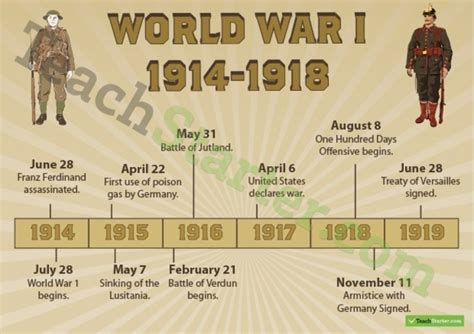When Did Ww1 And Ww2 End? Key Dates Explained

The world has witnessed two of the most devastating conflicts in human history: World War I and World War II. These global wars had a profound impact on the world, causing unprecedented destruction, loss of life, and a profound reshaping of the global political landscape. Understanding the key dates of these conflicts is essential to grasping their significance and the implications they had on the world. In this article, we will delve into the key dates that marked the end of World War I and World War II, exploring the historical context, the events leading up to their conclusions, and the lasting impacts these wars have had on global politics, society, and economy.
World War I: The Great War

World War I, also known as the Great War, began in 1914 and lasted until 1918. It was a global conflict involving many of the major powers of Europe, including Germany, France, Britain, and Russia. The war was fought on multiple fronts, including the Western Front in France and Belgium, the Eastern Front in Russia, and the Italian Front in Italy. The United States entered the war in 1917, playing a significant role in the ultimate defeat of the Central Powers.
The Armistice and Treaty of Versailles
The end of World War I is marked by two key dates: November 11, 1918, when the Armistice of Compiègne was signed, and June 28, 1919, when the Treaty of Versailles was signed. The Armistice of Compiègne was an agreement between the Allied Powers and Germany to cease hostilities on the Western Front, effective at 11:00 AM on November 11, 1918. This armistice was not a formal surrender but rather a temporary cessation of hostilities to allow for negotiations. The Treaty of Versailles, signed nearly seven months later, officially ended the state of war between Germany and the Allied Powers. The treaty imposed severe penalties on Germany, including significant territorial losses, heavy reparations, and limitations on its military capabilities. These provisions are often cited as contributing factors to the rise of Nazi Germany and the outbreak of World War II.
| Event | Date |
|---|---|
| Armistice of Compiègne | November 11, 1918 |
| Treaty of Versailles | June 28, 1919 |

World War II: The Second Great War

World War II began in 1939 when Nazi Germany, led by Adolf Hitler, invaded Poland. This act of aggression prompted the United Kingdom and France to declare war on Germany, marking the beginning of the conflict in Europe. Over the next six years, the war expanded to include more countries, including the Soviet Union, the United States, Japan, and China, making it a truly global conflict. The war was fought on multiple fronts, including Europe, Africa, and Asia, and involved a wide range of military operations, from large-scale battles and sieges to guerrilla warfare and strategic bombing campaigns.
The End of World War II in Europe and the Pacific
The end of World War II is marked by two key dates in different parts of the world: May 8, 1945, for Europe, known as V-E Day (Victory in Europe Day), and September 2, 1945, for the Pacific, known as V-J Day (Victory over Japan Day). In Europe, the surrender of Germany was formalized on May 8, 1945, following the death of Adolf Hitler and the collapse of the German military. The surrender was the result of the Allied invasion of Germany from the west and the Soviet advance from the east, culminating in the capture of Berlin. In the Pacific, the war ended with the formal surrender of Japan on September 2, 1945, aboard the USS Missouri in Tokyo Bay, Japan. This surrender followed the atomic bombings of Hiroshima and Nagasaki by the United States in August 1945 and the declaration of war against Japan by the Soviet Union.
| Event | Date |
|---|---|
| V-E Day (Europe) | May 8, 1945 |
| V-J Day (Pacific) | September 2, 1945 |
In conclusion, understanding the key dates that mark the end of World War I and World War II provides valuable insights into the complex history of these global conflicts. The Treaty of Versailles and the Armistice of Compiègne for World War I, and V-E Day and V-J Day for World War II, are not just historical events but milestones that have shaped the modern world. The aftermath of these wars has had lasting impacts on international relations, global security, and the formation of the United Nations, highlighting the importance of diplomacy, cooperation, and the pursuit of peace in the face of conflict.
What were the main reasons for the end of World War I?
+The main reasons for the end of World War I include the economic exhaustion of the Central Powers, the entry of the United States into the war, and the successful Allied advances on the Western Front, culminating in the Armistice of Compiègne and the subsequent Treaty of Versailles.
What led to the end of World War II in Europe?
+The end of World War II in Europe was led by the Allied invasion of Germany, the Soviet advance from the east, and the eventual capture of Berlin, resulting in the surrender of Germany on May 8, 1945, known as V-E Day.
What were the key factors that led to Japan’s surrender in World War II?
+The key factors that led to Japan’s surrender include the atomic bombings of Hiroshima and Nagasaki by the United States, the declaration of war against Japan by the Soviet Union, and the Allied naval blockade and strategic bombing campaign against Japan, culminating in the formal surrender on September 2, 1945, known as V-J Day.



